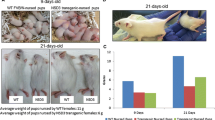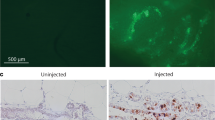Summary
Human adenovirus type 9 (Ad9) elicits exclusively estrogen-dependent mammary tumors when injected into female rats. Three different histological types of mammary tumor (benign fibroadenomas, phyllodes tumors, and malignant solid sarcomas) have been described in Ad9-infected animals, with benign fibroadenomas being seen most frequently. Interestingly, in contrast to other adenoviruses, in which oncogenic viral functions are entirely encoded within the E1 region, Ad9 requires an E4 region transforming protein (ORF1) for its unique mammary oncogenicity. Studies of Ad9-induced rat mammary tumors may lead to a detailed molecular understanding for the development of fibroadenoma, a common human breast tumor.
Similar content being viewed by others
References
Horwitz MS: Adenoviruses.In: Fields BN (ed) Virology. Raven Press, New York, 1990, pp 1723–1740
Horwitz MS: Adenoviridae and their replication.In: Fields BN (ed) Virology. Raven Press, New York, 1990, pp 1679–1721
Pereira HG, Huebner RJ, Ginsberg HS, Van Der Veen J: A short description of the adenovirus group. Virol 20:613–620, 1963
Green M, Mackey JK, Wold WSM, Rigden P: Thirty-one human adenovirus serotypes (Ad1-Ad31) form five groups (A-E) based upon DNA genome homologies. Virol 93:481–492, 1979
Graham FL: Transformation by and oncogenicity of human adenoviruses.In: Ginsberg HS (ed) The adenoviruses. Plenum Press, New York, 1984, pp 339–398
Trentin JJ, Yabe Y, Taylor G: Quest for human cancer viruses. Science 137:835–841, 1962
Shenk T, Flint J: Transcriptional and transforming activities of the adenovirus E1 A proteins. Adv Cancer Res 57:47–85, 1991
Stillman B: Functions of the adenovirus E1B tumour antigens. Cancer Surv 5:389–404, 1986
Whyte P, Buchkovich KJ, Horowitz JM, Friend SH, Raybuck M, Weinberg RA, Harlow E: Association between an oncogene and an anti-oncogene: the adenovirus E1A proteins bind to the retinoblastoma gene product. Nature 334:82–85, 1988
Ewen ME, Xing YG, Lawrence JB, Livingston DM: Molecular cloning, chromosomal mapping, and expression of the cDNA for p107, a retinoblastoma gene product-related protein. Cell 66:1155–1164, 1991
Hannon GJ, Demetrick D, Beach D: Isolation of the Rb-related p130 through its interaction with CDK2 and cyclins. Genes Dev 7:2378–2391, 1993
Bookstein R, Lee WH: Molecular genetics of the retinoblastoma suppressor gene. Crit Rev Oncog 2:211–227, 1991
Nevins JR, Chellappan SP, Mudryj M, Hiebert S, Devoto S, Horowitz J, Hunter T, Pines J: E2F transcription factor is a target for the RB protein and the cyclin A protein. Cold Spring Harb Symp Quant Biol 56:157–162, 1991
Pines J, Hunter T: Human cyclin A is adenovirus E1A-associated protein p60 and behaves differently from cyclin B. Nature 346:760–763, 1990
Tsai LH, Harlow E, Meyerson M: Isolation of the human cdk2 gene that encodes the cyclin A- and adenovirus E1A-associated p33 kinase. Nature 353:174–177, 1991
Arany Z, Sellers W, Livingston DM, Eckner R: E1A-associated p300 and CREB-associated CBP belong to a conserved family of coactivators. Cell 77:799–800, 1994
Dyson N, Harlow E: Adenovirus E1A targets key regulators of cell proliferation. Cancer Surv 12:161–195, 1992
Sarnow P, Ho YS, Williams J, Levine AJ: Adenovirus E1b 58kD tumor antigen and SV40 large tumor antigen are physically associated with the same 54kD cellular protein in transformed cells. Cell 28:387–394, 1982
Finlay CA, Hinds PW, Levine AJ: The p53 proto-oncogene can act as a suppressor of transformation. Cell 57:1083–1093, 1989
Fields S, Jang SK: Presence of a potent transcription activating sequence in the p53 protein. Science 249:1046–1049, 1990
Raycroft L, Wu HY, Lozano G: Transcriptional activation by wild-type but not transforming mutants of the p53 anti-oncogene. Science 249:1049–1051, 1990
El Deiry WS, Tokino T, Velculescu VE, Levy DB, Parsons R, Trent JM, Lin D, Mercer WE, Kinzler KW, Vogelstein B: WAF1, a potential mediator of p53 tumor suppression. Cell 75:817–825, 1993
Harper JW, Adami GR, Wei N, Keyomarsi K, Elledge SJ: The p21 Cdk-interacting protein Cip1 is a potent inhibitor of G1 cyclin-dependent kinases. Cell 75:805–816, 1993
Yew PR, Berk AJ: Inhibition of p53 transactivation required for transformation by adenovirus early 1B protein. Nature 357:82–85, 1992
Yew PR, Liu X, Berk AJ: Adenovirus E1B oncoprotein tethers a transcriptional repression domain to p53. Genes Dev 8:190–202, 1994
Ankerst J, Jonsson N, Kjellen L, Norrby E, Sjogren HO: Induction of mammary fibroadenomas in rats by adenovirus type 9. Int J Cancer 13:286–290, 1974
Javier R, Raska KJ, Macdonald GJ, Shenk T: Human adenovirus type 9-induced rat mammary tumors. J Virol 65:3192–3202, 1991
Brusca JS, Jannun R, Chinnadurai R: Efficient transformation of rat 3Y1 cells by human adenovirus type 9. Virology 136:328–337, 1984
Jannun R, Chinnadurai G: Functional relatedness between E1a and E1b regions of group C and group D human adenoviruses. Virus Res 7:33–48, 1987
Jonsson N, Ankerst J: Studies on adenovirus type 9-induced mammary fibroadenomas in rats and their malignant transformation. Cancer 39:2513–2519, 1977
Robbins SL, Angell M, Kumar V: Basic Pathology. W.B. Saunders, Philadelphia, 1981, pp 564–595
Rosai J: Ackerman's Surgical Pathology. Mosby, St. Louis, 1989, pp 1193–1267
Diaz NM, Palmer JO, McDivitt RW: Carcinoma arising within fibroadenomas of the breast. A clinicopathologic study of 105 patients. Am J Clin Pathol 95:614–622, 1991
Mechtersheimer G, Kruger KH, Born IA, Moller P: Antigenic profile of mammary fibroadenoma and cystosarcoma phyllodes. A study using antibodies to estrogen- and progesterone receptors and to a panel of cell surface molecules. Pathol Res Pract 186:427–438, 1990
Koerner FC, O'Connell JX: Fibroadenoma: morphological observations and a theory of pathogenesis. Pathol Annu 1:1–19, 1994
Nandi S, McGrath CM: Mammary neoplasia in mice. Adv Cancer Res 17:353–414, 1973
Rose DP.In: Bulbrook RD, Taylor DJ (eds) Commentaries on Research in Breast Disease. Alan R. Liss, New York, 1979, pp 111–145
Ankerst J, Jonsson N: Adenovirus type 9-induced tumorigenesis in the rat mammary gland related to sex hormonal state. J Natl Cancer Inst 81:294–298, 1989
Meyer JE, Frenna TH, Polger M, Sonnenfeld MR, Shaffer K: Enlarging occult fibroadenomas. Radiology 183:639–641, 1992
Ansah BY, Tavassoli FA: Fibroadenoma and cystosarcoma phyllodes of the male breast. Mod Pathol 5:114–116, 1992
Tyler KL, Fields BN: Pathogenesis of viral infections.In: Fields BN (ed) Virology. Raven Press, New York, 1990, pp 191–239
Noguchi S, Motomura K, Inaji H, Imaoka S, Koyama H: Clonal analysis of fibroadenoma and phyllodes tumor of the breast. Cancer Res 53:4071–4074, 1993
Stephenson CF, Davis RI, Moore GE, Sandberg AA: Cytogenetic and fluorescence in situ hybridization analysis of breast fibroadenomas. Cancer Genet Cytogenet 63:32–36, 1992
Javier R, Raska KJ, Shenk T: Requirement for the adenovirus type 9 E4 region in production of mammary tumors. Science 257:1267–1271, 1992
Herisse J, Rigolet M, de Dinechin SD, Galibert F: Nucleotide sequence of adenovirus 2 DNA fragment encoding for the carboxylic region of fiber protein and the entire E4 region. Nucleic Acids Res 9:4023–4042, 1981
Hogenkamp T, Esche H: Nucleotide sequence of the right 10% of adenovirus type 12 DNA encoding the entire region E4. Nucleic Acids Res 18:3065–3066, 1990
Javier RT: Adenovirus type 9 E4 open reading frame 1 encodes a transforming protein required for the production of mammary tumors in rats. J Virol 68:3917–3924, 1994
Author information
Authors and Affiliations
Corresponding author
Rights and permissions
About this article
Cite this article
Javier, R., Shenk, T. Mammary tumors induced by human adenovirus type 9: A role for the viral early region 4 gene. Breast Cancer Res Tr 39, 57–67 (1996). https://doi.org/10.1007/BF01806078
Issue Date:
DOI: https://doi.org/10.1007/BF01806078




